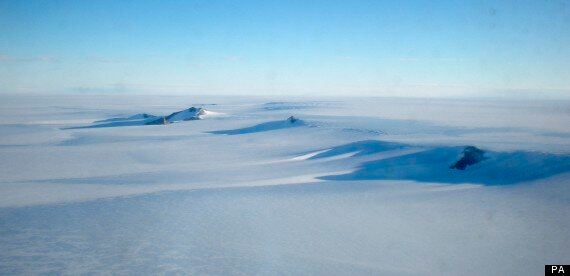The discovery of bacteria which thrives in a salty, ice-sealed Antarctic lake has strengthened the possibility of alien life on planets such as Mars.
Lake Vida, which is located in the region’s McMurdo Dry Valleys, contains no oxygen, is mostly frozen and possesses the highest nitrous oxide levels of any natural water body on Earth.
A briny liquid that is approximately six times saltier than seawater percolates throughout the icy environment that has an average temperature of minus 13.5 degrees centigrade (8 degrees Fahrenheit).

The discovery of bacteria in an Antarctic lake strengthens the possibility of alien life on other planets (file picture)
Dr Peter Doran, of the University of Illinois in Chicago, told New Scientist: “Lake Vida is a model of what happens when you try to freeze a lake solid, and this is the same fate that any lakes on Mars would have gone through as the planet turned colder from a watery past.
“Any Martian water bodies that did form would have gone through this Vida stage before freezing solid, entombing the evidence of the past ecosystem.”
The findings are published in the Proceedings of the National Academy of Sciences journal (PNAS), and were co-authored by Dr Alison Murray and Dr Christian Fritsen, of Nevada’s Desert Research Institute (DRI).
SEE ALSO:
The bacteria was found to exist beneath nearly 20 meters of ice on the lake, which is one of the region’s most isolated bodies of water.
Geochemical analyses suggest that chemical reactions between the brine and the underlying iron-rich sediments generate nitrous oxide and molecular hydrogen. The latter, in part, may provide the energy needed to support the brine's diverse microbial life.
"It's plausible that a life-supporting energy source exists solely from the chemical reaction between anoxic salt water and the rock," explained Fritsen, a systems microbial ecologist and Research Professor in DRI's Division of Earth and Ecosystem Sciences.
"If that's the case," echoed Murray, "this gives us an entirely new framework for thinking of how life can be supported in cryoecosystems on earth and in other icy worlds of the universe."
Although he was not involved in the recent research, Dr Cynan Ellis-Evans, from the British Antarctic Survey, told the BBC News: “There are various lakes that are very salty down there… but this is a really freaky one.”
"This study provides a window into one of the most unique ecosystems on Earth," said Murray, a molecular microbial ecologist and polar researcher for the past 17 years, who has participated in 14 expeditions to the Southern Ocean and Antarctic continent.

Lake Vida is a model of what would have occurred when lakes on Mars froze solid, claims Dr Doran claims
"Our knowledge of geochemical and microbial processes in lightless icy environments, especially at subzero temperatures, has been mostly unknown up until now. This work expands our understanding of the types of life that can survive in these isolated, cryoecosystems and how different strategies may be used to exist in such challenging environments."
Despite the very cold, dark and isolated nature of the habitat, the report finds that the brine harbors a surprisingly diverse and abundant assemblage of bacteria that survive without a present-day source of energy from the sun.
Previous studies of Lake Vida dating back to 1996 indicate that the brine and its' inhabitants have been isolated from outside influences for more than 3,000 years.
The team developed stringent protocols and specialised equipment for their 2005 and 2010 field campaigns to sample the lake brine while avoiding contaminating the pristine ecosystem.
To sample the unique environment researchers worked under secure, sterile tents on the lake's surface to keep the site and equipment clean as they drilled ice cores, collected samples of the salty brine residing in the lake ice and then assessed the chemical qualities of the water and its potential for harboring and sustaining life, in addition to describing the diversity of the organisms detected.
Murray added further research is currently under way to analyse the abiotic, chemical interactions between the Lake Vida brine and the sediment, in addition to investigating the microbial community by using different genome sequencing approaches. The results could help explain the potential for life in other salty, cryogenic environments beyond Earth.
The Lake Vida brine also represents a cryoecosystem that is a suitable and accessible analog for the soils, sediments, wetlands, and lakes underlying the Antarctic ice sheet that other polar researchers are just now beginning to explore.